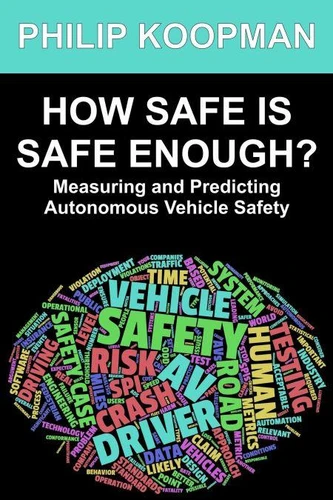How Safe Is Safe Enough?: Measuring and Predicting Autonomous Vehicle Safety
Par :Formats :
Disponible dans votre compte client Decitre ou Furet du Nord dès validation de votre commande. Le format ePub est :
- Compatible avec une lecture sur My Vivlio (smartphone, tablette, ordinateur)
- Compatible avec une lecture sur liseuses Vivlio
- Pour les liseuses autres que Vivlio, vous devez utiliser le logiciel Adobe Digital Edition. Non compatible avec la lecture sur les liseuses Kindle, Remarkable et Sony
 , qui est-ce ?
, qui est-ce ?Notre partenaire de plateforme de lecture numérique où vous retrouverez l'ensemble de vos ebooks gratuitement
Pour en savoir plus sur nos ebooks, consultez notre aide en ligne ici
- FormatePub
- ISBN8215045954
- EAN9798215045954
- Date de parution12/03/2023
- Protection num.pas de protection
- Infos supplémentairesepub
- ÉditeurWMG Publishing
Résumé
The most pressing question regarding autonomous vehicles is: will they be safe enough? The usual metric of "at least as safe as a human driver" is more complex than it might seem. Which human driver, under what conditions? And are fewer total fatalities OK even if it means more pedestrians die? Who gets to decide what safe enough really means when billions of dollars are on the line? And how will anyone really know the outcome will be as safe as it needs to be when the technology initially deploys without a safety driver?This book is written by an internationally known expert with more than 25 years of experience in self-driving car safety.
It covers terminology, autonomous vehicle (AV) safety challenges, risk acceptance frameworks, what people mean by "safe, " setting an acceptable safety goal, measuring safety, safety cases, safety performance indicators, deciding when to deploy, and ethical AV deployment. The emphasis is not on how to build machine learning based systems, but rather on how to measure whether the result will be acceptably safe for real-world deployment.
Written for engineers, policy stakeholders, and technology enthusiasts, this book tells you how to figure out what "safe enough" really means, and provides a framework for knowing that an autonomous vehicle is ready to deploy safely.
It covers terminology, autonomous vehicle (AV) safety challenges, risk acceptance frameworks, what people mean by "safe, " setting an acceptable safety goal, measuring safety, safety cases, safety performance indicators, deciding when to deploy, and ethical AV deployment. The emphasis is not on how to build machine learning based systems, but rather on how to measure whether the result will be acceptably safe for real-world deployment.
Written for engineers, policy stakeholders, and technology enthusiasts, this book tells you how to figure out what "safe enough" really means, and provides a framework for knowing that an autonomous vehicle is ready to deploy safely.
The most pressing question regarding autonomous vehicles is: will they be safe enough? The usual metric of "at least as safe as a human driver" is more complex than it might seem. Which human driver, under what conditions? And are fewer total fatalities OK even if it means more pedestrians die? Who gets to decide what safe enough really means when billions of dollars are on the line? And how will anyone really know the outcome will be as safe as it needs to be when the technology initially deploys without a safety driver?This book is written by an internationally known expert with more than 25 years of experience in self-driving car safety.
It covers terminology, autonomous vehicle (AV) safety challenges, risk acceptance frameworks, what people mean by "safe, " setting an acceptable safety goal, measuring safety, safety cases, safety performance indicators, deciding when to deploy, and ethical AV deployment. The emphasis is not on how to build machine learning based systems, but rather on how to measure whether the result will be acceptably safe for real-world deployment.
Written for engineers, policy stakeholders, and technology enthusiasts, this book tells you how to figure out what "safe enough" really means, and provides a framework for knowing that an autonomous vehicle is ready to deploy safely.
It covers terminology, autonomous vehicle (AV) safety challenges, risk acceptance frameworks, what people mean by "safe, " setting an acceptable safety goal, measuring safety, safety cases, safety performance indicators, deciding when to deploy, and ethical AV deployment. The emphasis is not on how to build machine learning based systems, but rather on how to measure whether the result will be acceptably safe for real-world deployment.
Written for engineers, policy stakeholders, and technology enthusiasts, this book tells you how to figure out what "safe enough" really means, and provides a framework for knowing that an autonomous vehicle is ready to deploy safely.







